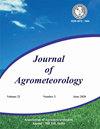Co-elevation of atmospheric CO2 and temperature affect instantaneous and intrinsic water use efficiency of rice varieties
Q3 Agricultural and Biological Sciences
引用次数: 0
Abstract
Greenhouse gas (GHG) emissions from anthropogenic activities are the most significant drivers of climate change, which has both direct and indirect effects on crop production. The study was conducted during the kharif season for two years inside the Open Top Chamber (OTC) at the Genetic-H field of ICAR-Indian Agriculture Research Institute (IARI) to quantify the effect of elevated CO2 and temperature on water use efficiency of rice varieties. There were two different CO2 concentrations i.e. ambient (410 ppm) and elevated (550 ± 25 ppm) and also two different temperature levels i.e. ambient and elevated (+2.5-2.9°C). Results suggested that warming caused more accumulated GDD in rice and which negatively affected the duration of both the varieties. In elevated CO2 plus high temperature interaction treatment net photosynthesis rate was more than that of chamber control. Stomatal conductance and transpiration rate reduced with co-elevation of CO2 and temperature. Co-elevation of CO2 and temperature, has also improved WUE (both instantaneous and intrinsic) through enhanced carbon assimilation and reduced stomatal conductance, thus, reducing the amount of water lost through transpiration, eventually improving WUE of the crop.大气CO2和温度的共同升高影响水稻品种的瞬时和内在水分利用效率
人为活动产生的温室气体排放是气候变化的最重要驱动因素,对作物生产有直接和间接影响。这项研究在哈里夫季节在ICAR印度农业研究所(IARI)Genetic-H田地的开放式试验室(OTC)内进行了两年,以量化二氧化碳和温度升高对水稻品种水分利用效率的影响。有两种不同的CO2浓度,即环境(410ppm)和升高(550±25ppm),以及两种不同温度水平,即环境和升高(+2.5-2.9°C)。结果表明,变暖导致水稻积累更多的GDD,并对两个品种的持续时间产生负面影响。在高CO2加高温交互作用处理中,净光合作用速率高于室内对照。气孔导度和蒸腾速率随CO2和温度的升高而降低。CO2和温度的共同升高也通过增强碳同化和降低气孔导度提高了WUE(瞬时和内在),从而减少了蒸腾损失的水量,最终提高了作物的WUE。
本文章由计算机程序翻译,如有差异,请以英文原文为准。
求助全文
约1分钟内获得全文
求助全文
来源期刊

Journal of Agrometeorology
农林科学-农艺学
CiteScore
1.40
自引率
0.00%
发文量
95
审稿时长
>12 weeks
期刊介绍:
The Journal of Agrometeorology (ISSN 0972-1665) , is a quarterly publication of Association of Agrometeorologists appearing in March, June, September and December. Since its beginning in 1999 till 2016, it was a half yearly publication appearing in June and December. In addition to regular issues, Association also brings out the special issues of the journal covering selected papers presented in seminar symposia organized by the Association.
 求助内容:
求助内容: 应助结果提醒方式:
应助结果提醒方式:


